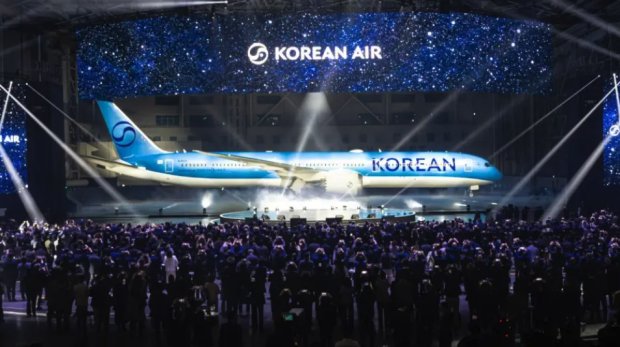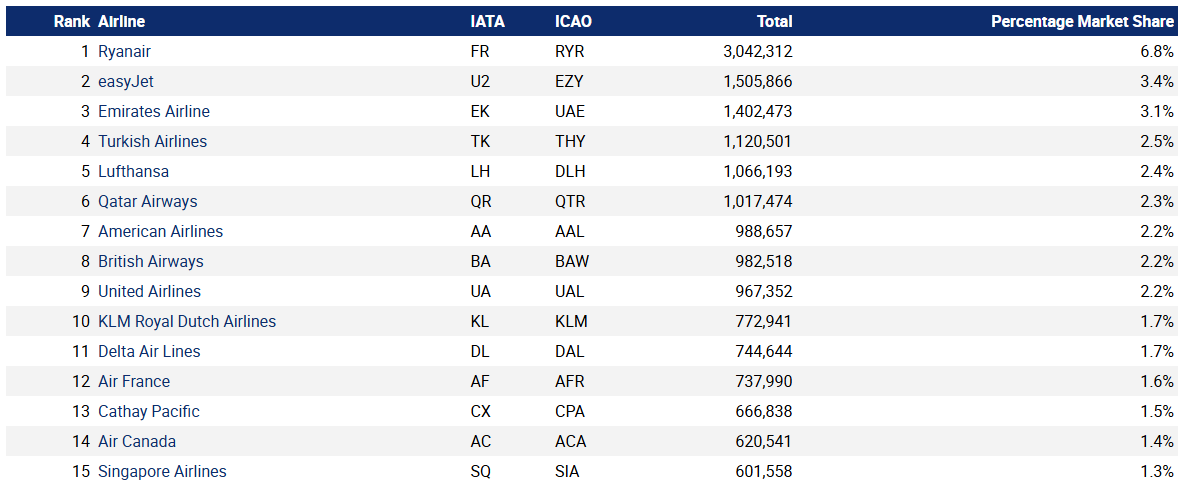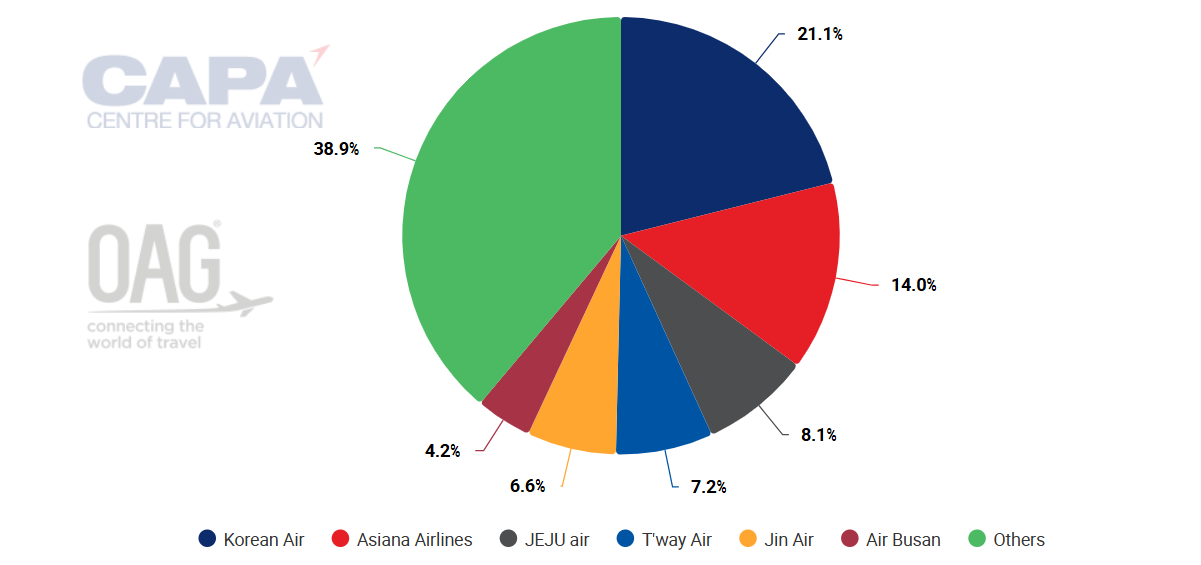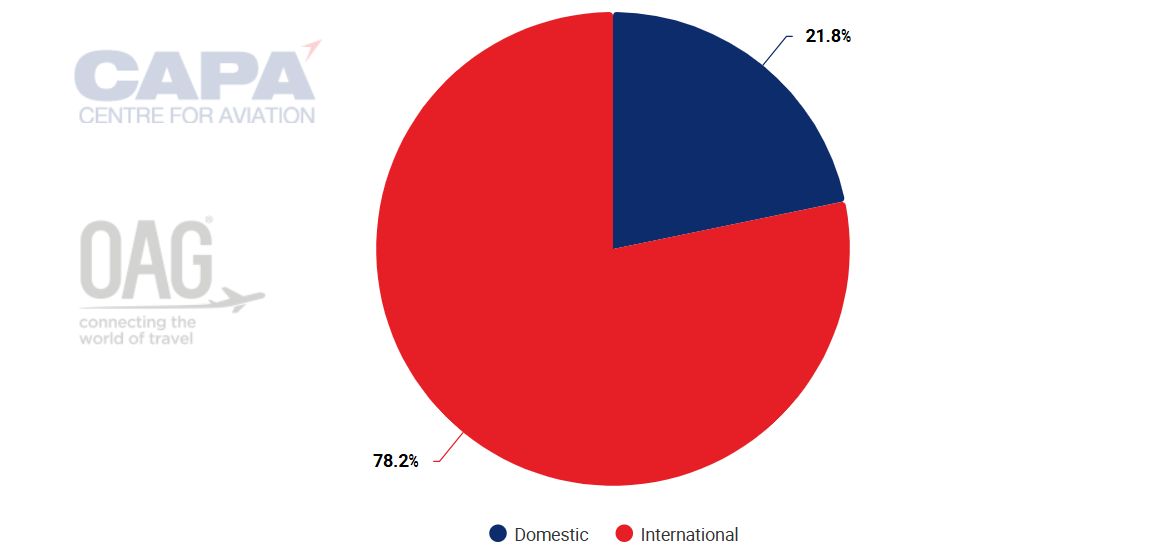Korean Air’s new look underlines its global ambitions following Asiana merger

Korean Air's sweeping brand update is about more than just about aesthetics - it also reflects the airline's shift to a more global mindset, enabled by the expansion that will occur after it absorbs Asiana Airlines.
The new branding, which involves significant changes to its logos and aircraft livery, is the most visible aspect of a broader revision of the airline's corporate identity. This has been prompted by Korean Air's acquisition of Asiana, which was finalised in Dec-2024 after a multi-year campaign to gain regulatory approvals in several countries.
Asiana will be a Korean Air subsidiary until the integration is completed in Jan-2027, and much work will be needed in the meantime to ensure the merger of two large airlines goes smoothly.
The merger will mean fleet and network growth for Korean Air, and the new corporate identity aligns with its ambition to play a larger role in connecting different markets across the world.
As one executive puts it, Korean Air will be not just a South Korean flag carrier, but a major global airline that is based in Korea.
Summary
- Korean Air will paint much of its own fleet first, with Asiana aircraft to follow in 2027.
- A380s and 747-8i phase-out has been postponed due to delivery delays of other aircraft.
- The combined airline will move into the list of the world’s top 15 largest airlines.
- Ratio of overseas-based customers on Korean Air’s flights has increased since the COVID pandemic.
- IT standardisation will be key, as data is migrated into 154 of Korean’s systems.
Repainting the fleet is a key step in promoting the expanded airline's new corporate identity
Korean Air's rebranding will affect almost 30,000 types of items - ranging from employee badges to airport and lounge signage, and aircraft liveries.
Much of the signage was changed over within hours of the rebranding being announced on 11-Mar-2025, but repainting the fleet will take much longer.
The airline has unveiled the first aircraft with its new livery - a freshly delivered Boeing 787-10. It showcases the airline's first major brand update in 41 years.
While Korean Air has retained the sky-blue main fuselage colour, the paint now has a metallic effect.
The fuselage will bear the word Korean, rather than Korean Air; the lettering has been changed, and will be much larger. The familiar red-and-blue Taegeuk tail symbol has been simplified and stylised in dark blue.
The airline will start repainting its current fleet of more than 160 aircraft first, Korean Air Chief Marketing Officer Kenneth Chang told Aviation Week Network in a recent interview in Seoul.
It is aiming to paint at least 30 this year. All new deliveries will arrive with the new livery, and aircraft involved in retrofit programs - such as Korean Air's Boeing 777s - will be repainted as part of that process.
Korean Air plans to begin the major task of painting the Asiana fleet after the merger completion date in 2027.
Korean Air has its own paint facility in its engineering division near Busan, but it will likely have to send some aircraft overseas to be painted due to the large number involved, Mr Chang says.
The A380s and 747-8Is are not part of the long term plan for the expanded airline, but the timing of their phase-out is uncertain
The airline is yet to decide whether to repaint aircraft types it intends to phase out, such as its Airbus A380s and Boeing 747-8 passenger versions, says Korean CEO and Chairman Walter Cho.
Korean Air previously intended to phase out its A380s beginning this year, but it has postponed this step to help cover for significant delivery delays of other new aircraft. Mr Cho says that both Boeing and Airbus are about 20 aircraft behind where they should be, in terms of deliveries.
The exit of the 747-8 passenger jets has been postponed for the same reason.
The phase-out of both types will resume when the airline has enough aircraft delivered to serve its network, Mr Cho says.
So, although the initial repainting schedule did not include these four-engined passenger widebodies, it may have to be tweaked to accommodate them after all.
Korean Air has put a lot of effort into deciding what its post-merger role will be as it climbs list of largest airlines
Developing the myriad elements of the new corporate identity took three years, including nine months of planning the execution of the company-wide conversion to the new brand.
The initiative was sparked by the impending takeover of Asiana, Mr Chang says.
Korean Air had previously been one of two major airlines in South Korea, but the merger will make it the de facto airline representing the country. And beyond that, the increased scale of the combined airline will enable it to boost its image as a truly global entity.
Korean Air was the 24th largest airline by international seat capacity for the week of 24-Mar-2025, and Asiana was 42nd, according to data from CAPA - Centre for Aviation and OAG.
The merger would make Korean Air the 13th largest international airline based on that week's data, and the largest from the Asia-Pacific region.
The chart below shows the current top 15. Korean Air will slot in just below Air France after the merger, and one higher than Cathay Pacific.
The combined Korean Air/Asiana fleet would have approximately 250 aircraft, mainly widebodies (not counting LCC subsidiaries).
Top 15 airlines by international capacity, as measured in seats for the week of 24-Mar-2025

Source: CAPA - Centre for Aviation and OAG.
Of course, Korean Air's dominance within the South Korean international market will be even greater.
The chart below shows that, combined with Asiana, it would account for 35.1% of South Korea's international weekly seats, including overseas airlines.
Adding in LCC subsidiaries Jin Air and Air Busan would lift the Korean Air share to almost 46%.
South Korea's international departing seats, by airline, for the week of 24-Mar-2025 (includes overseas airlines)

Source: CAPA - Centre for Aviation and OAG.
Increasing the ratio of overseas-based customers is an important facet of Korean Air's international growth plans
Korean Air's operations are skewed heavily towards international services, which account for most of its capacity.
The chart below shows that for the week of 24-Mar-2025, nearly 80% of the airline's weekly seats were on international flights.
For the same week, nearly 98% of ASKs were international, and 72% of departing frequencies.
Korean Air: international vs domestic capacity, as measured in seats for the week of 24-Mar-2025

Source: CAPA - Centre for Aviation and OAG.
The airline is looking to build up the number of non-Korean customers, both on flights to and from Korea, as well as connecting between other countries via its Seoul hub.
Korean Air is already making progress towards that goal, Mr Chang says.
Before COVID-19, the airline's non-Korean passenger base on international routes was around 40%.
During the post-pandemic period, however, this ratio has flipped, with non-Koreans representing 60% of passengers.
Importantly, many of the new overseas customers are also joining the airline's loyalty program.
Transit traffic between North America and elsewhere in Asia has been particularly strong for Korean Air since the COVID-19 pandemic.
This trend "showed us the potential is there," so the airline considered what it needed to do to boost its connecting traffic further, says Mr Chang.
A big part of the answer will be to expand the network. Korean Air's larger scale, and its greater footprint at its hub airport, will give it "more freedom to develop new routes," says Mr Chang.
To fulfil its global ambitions, the airline will look to extend coverage to markets such as Africa and Latin America - through partnerships, and with its own aircraft.
It will also look to grow in some of its strongest markets, such as North America.
Korean Air will soon begin rearranging its own and Asiana's flight timings on routes they both serve where arrivals are very close together, Mr Chang says. In some cases, capacity can be shifted to other markets.
Employees will get new uniforms - but integrating the workgroups will be challenging
As with any airline merger, one of the most important aspects will be combining the workforces of Asiana and Korean Air.
"The biggest challenge in merging will not be the systems, but the culture - especially for two different companies [that are] long-time competitors", Mr Chang notes.
Korean is aiming for "a very gradual DNA change" for the combined workforce. Even before the formal integration date, there will be some areas of training that the companies can conduct together.
The airline has stated that it will not be reducing combined employee numbers due to the merger.
Korean Air is already short of some types of staff, such as cabin crew, Mr Chang says. Together, the airlines will have about 10,000 cabin crew.
A new uniform will be introduced on the day of integration.
One of the most important and complex aspects of the merger will happen behind the scenes
The IT transition will be another major task, involving 154 of Korean Air's systems. These cover a wide range of areas from aircraft maintenance to crew processes.
Asiana's data cannot be fully migrated into Korean Air's IT systems until the airlines formally merge, but Korean Air can look at the Asiana systems through a "clean task force." The task force can request samples from Asiana IT systems.
Korean Air has discovered that Asiana's IT systems and terminology are more different from its own than it expected, Mr Chang says. This makes data standardisation crucial, and working groups have been created to achieve this for each department.
For some of the most complex systems, Korean Air will create a cloned test environment and import sample data from Asiana.
In such cases the standardisation and migration exercise will take about two years, Mr Chang says. Theoretically, it could be done in three months, "but we want to make sure we migrate it correctly".
The linked merger and rebranding efforts are massive undertaking, but Korean Air is taking time to get planning and execution right
Tackling the change in branding and corporate identity before the full merger of the two airlines is a sensible idea. This will allow Korean Air to bed in these changes before fully absorbing the Asiana employees and systems.
However, the airline will still face a challenging few years, as it will be completing elements of the branding change at the same time as it works on the merger preparation.
But Korean Air is not rushing either process, and its methodical approach gives confidence that it will accomplish its transformation without disruption.
Korean Air's rebranding and new livery needs to be considered not just in the context of its visual impact, but also in terms of what the airline is trying to achieve.
Changing Korean Air to Korean on aircraft fuselages shows that the airline has become the country's only major full service carrier.
While there are some rising smaller airlines, they are far below Korean Air's size.
The airline does have to make some significant concessions to gain the approvals it needed for the merger - such as divesting the Asiana cargo unit - but overall the deal is still very positive for Korean Air.
As more details emerge, it is becoming more apparent what the expanded airline will look like and how it plans to evolve.
The airline is due to report to the Korean government in Jun-2025 about the progress of the merger, and what its next steps will be.


